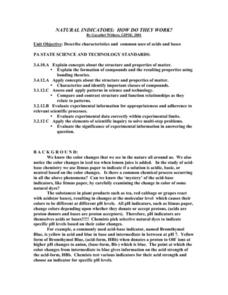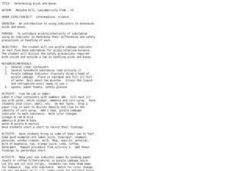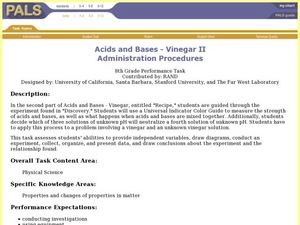Curated OER
Acids and Bases Are All Around
In this acids and bases worksheet, students read a 1 page article on acids and bases and answer 10 true or false, short answer, multiple choice and/or fill in the blank questions or statements referring back to the article.
Curated OER
Trapezoids
In this trapezoids worksheet, 10th graders solve 5 different problems related to trapezoids and applying the appropriate theorem. First, they define a trapezoid, including its bases, legs, and base angles. Then, students use the...
Curated OER
Acids and Bases Crossword
For this chemistry worksheet, students complete a crossword puzzle with 27 clues about acids and bases. Each clue lists number of letters for correct word.
Curated OER
Answers for Acids and Bases Crossword
In this chemistry worksheet, students are provided with the answers for a crossword puzzle with 27 clues about acids and bases.
Curated OER
Acids and Bases-pH Experiment
In this chemistry lab worksheet, student use pH paper to test the pH of common household items. After collecting and charting their data, they complete 12 follow-up questions.
Curated OER
pH Pre-Lab: Acids and Bases
In this chemistry lab, students determine whether or not their saliva is acidic, basic, or neutral. After completing their test, they answer 6 analysis questions.
Curated OER
Water Ph
Eighth graders study the concepts of acids, bases, salts and neutralization. They discuss steam adoption program, acid rain and other ecological implications. They use indicators to obtain pH values of household chemicals and to...
Curated OER
Hit a Homer in PE!
Students are introduced to PE rules. They are given feedback on their behavior in class using a bulletin board. Students gather around the bulletin board at the end of each period, if the class followed all the rules that are written...
Curated OER
Natural Indicators: How Do They Work?
Students describe characteristics and common uses of acids and bases. They describe the role of natural indicators in the chemistry of acids and bases after testing and making observations on a variety of plant extracts. Students observe...
Curated OER
Seeing Numbers In Tens And Ones
Second graders develop the skill of place values up to the tens place. They practice identifying the values of 2 digit numbers and writing the correlating values with counting. They use the example of money to make the lesson more...
Curated OER
What is the Best Solution to Dye Easter Eggs?
Young scholars use red and blue litmus paper to determine the category of common substances. They then set up an experiment using vinegar, water, and ammonia (or milk of magnesia) to determine that acids make the best solution for dyeing...
Curated OER
Invisible Ink
Students wxplore acids and indicators by watching a demostration in which "magic" ink appears. They duplicate the demonstration by writing magic messages using phenolphthalein solution and painting the message with vinegar to show it.
Curated OER
Colorful Milk of Magnesia
Students explore acids, bases, and indicators. They observe the various colors of an acid-base indicator solution and the neutralization of an acidic solution by an antacid.
Curated OER
Introduction to Neutraliization
Students explore acids and bases and the process of neutralization.T hey practice volume measurements and observe the neutralization of an acid
directly through bubble formation and indirectly through indicator color changes.
Curated OER
Sour Acids and Bitter Bases
Pupils explore acids and bases. They experience the sour taste of acids and the bitter taste of bases by tasting substances such as chocolate, lemon juice, and baking soda. in addition, they complete a worksheet for individual assessment.
Curated OER
Acid and Base Testing 2
Students design and conduct an experiment on unknown solutions after studying descriptions of indicators and the way in which they identify acids and bases. Students must gather, organize, and analyze data as well as make inferences...
Curated OER
Every Breath You Take
Students study acids and bases and the uses of indicators. They interpret the actions of an indicator to conclude that bromothymol blue turns yellow in the presence of a weak acid.
Curated OER
Why Do We Add The Bases To Find The Area of A Trapezoid?
Young scholars are given patterns of trapezoids and are to calculate the area of one trapezoid by using both patterns. They should form a parallelogram and calculate the area. They practice this technique until there is understanding.
Curated OER
Determining Acids and Bases
Students use purple cabbage indicator to test five know substances for acidic/alkaline balance. They discuss the safety precautions required both inside and outside a lab in handling acids and bases.
Curated OER
What is pH and Why is it Important?
Students investigate acids, bases, and pH, and related this knowledge to the problem of acid deposition.
Curated OER
The pH scale
Learners list the common properties of acids and bases. They classify substances as acids or bases, by using pH and litmus tests and are able to explain the pH scale. They participate in a lab activity which reinforce their understanding.
Curated OER
Determining The pH Of Common Substances
Students use a pH indicator to measure the pH of some fruits, common beverages, and borax. Students discover how to differentiate between an object that is an acid or a base.
Curated OER
Acids and Bases - Vinegar II
Eighth graders experiment what happens when acids and bases are mixed together. In this acids and bases experimental lesson, 8th graders decide which of three solutions of unknown pH will neutralize a fourth solution of unknown pH.
Alabama Learning Exchange
Trapezoids: What's Equal or Right About Them?
Pupils explore the concept of trapezoids. In this trapezoids instructional activity, young scholars identify legs and bases of a trapezoid. Pupils discuss the similarities and differences between isosceles trapezoids and right...

























